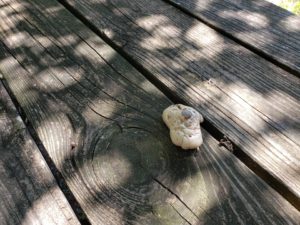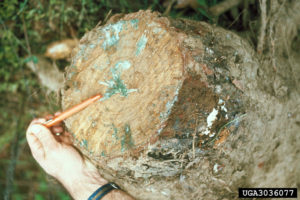Special article by Marcia Anderson, PhD, LTE; U.S. EPA Center for Integrated Pest Management
It’s that time of year to take a walk through a forest or your neighborhood. Are seeing mushrooms, the reproductive structure of a fungus, growing on rotting tree trunks or decaying woodchips? One of the main benefits of fungi is that they help break down and recycle organic material, making nutrients available for new life.
Depending on where you are located you might be seeing mushrooms growing in the woodchips on your playground. There is some concern when toddlers or small children are around as they tend to put everything in their mouths, including mushrooms. One of the easiest IPM solutions is roping off the area until the local cooperative extension service can identify the mushrooms as being non-toxic. This type of interaction serves as a reminder of how little most people know about fungi. There is, however, much to discover.

Commonly known as the aborted entoloma or shrimp of the woods, is an edible mushroom in the Entolomataceae family of fungi. Caution should be used in identifying the species before eating.
Fungi have been around for 1.3 billion years, but we are just beginning to discover many of their benefits. Aside from being a culinary treat, certain fungi are key elements in restoring ecosystems and allies in helping farmers protect valuable agricultural crops.
Although relatively unrecognized, fungi can be powerful tools in pollution remediation through a process known as mycoremediation. That is the use of fungi to break down or remove a range of contaminants, including oils and toxic chemicals, from the environment. This form of biological remediation can filter toxins from stormwater runoff and help clean up industrial oil spills.
These fungi can help us remove or detoxify chemicals, such as polycyclic aromatic hydrocarbons, polychlorinated biphenyls, petroleum compounds, and heavy metals like mercury and lead. How do they remove these chemicals? The fungal mycelium, or vegetative part of the fungus, absorbs and converts the hydrocarbons in these contaminants into carbohydrates. Research using oyster mushrooms has shown significant pollutant removal from both soil and water in remediation areas. Once used for bioremediation, the mushrooms are destroyed as toxic waste.

Turkey tail fungus (Trametes versicolor) helping to break down old trees.
Similarly, turkey tail mushrooms are suitable for mercury remediation, and garden giant mushrooms can be used for E. coli removal. Mycobooms, straw rafts containing mushroom mycelium, can absorb oil from water.
Fungi are also used as biological pesticides, or biopesticides, that target specific insect pests and plant diseases. Biopesticides are considered less toxic than their chemical counterparts and are comparatively safer environmentally. Termed mycoinsecticides, some fungi act as parasites of insects and can protect plants from certain infections and diseases, thereby enhancing crop production.
For example, one biological pesticide used in agriculture is Trichoderma spp., a beneficial fungus that colonizes plant roots and outcompetes disease-causing fungi. Trichoderma protects plants from soil-borne pathogens in non-food crops, fruiting vegetables, cole crops, legumes, herbs, cucurbits, berries, and small fruits. A side benefit is that, over time, it stimulates plant growth and increases plant defenses.

Wood rot fungi Trichoderma spp. Robert L. Anderson, USDA Forest Service, Bugwood.org
Another commercially used biopesticide, Beauveria bassiana, is a fungus that acts on insects including aphids, whiteflies, thrips, fire ants, and bedbugs. The fungal bodies adhere to the insect’s exoskeleton and slowly dissolve a hole in the insect’s body. The fungus penetrates the body, proliferates, and produces spores that subsequently liquefy the insect’s internal organs. Its slow action allows time for the target insect to pick up the fungal spores and infect the rest of the colony. The best news is that it does not affect non-target organisms.
Another fungal biopesticide, Pythium oligandrum, protects crops and turf from roughly 20 soil-borne pathogens. Muscodor albus is a fungal biopesticide that is an alternative to the fumigant methyl bromide. It is used to protect food commodities from post-harvest decay. It is also used on ornamental plants, seeds, and seedlings to protect against soil-borne diseases.
In tropical countries, manufacturers have combined the use of entomopathogenic biopesticides and insecticide-treated bed nets to control the mosquitoes that carry malaria. Sprays of some fungal spores are pathogenic to mosquitoes during specific stages of their life cycle and affect their metabolic and reproduction rates. Fungal infection consequently reduces the mosquito’s ability to transmit diseases. The World Health Organization has been testing the biopesticide Beauveria bassiana to reduce malarial transmission, resulting in a high mosquito mortality and rapid reductions in feeding and flight capability.
The growth of the biopesticide market, including these fungal-based controls, comes in response to the increasing demand for more natural pest control tools. Biopesticides can complement conventional chemical pesticides and are cost effective and eco-friendly. Biopesticides can be incorporated into any Integrated Pest Management program, contributing to sustainable pest control and healthy environment.
For more information on biopesticides, visit the EPA biopesticide webpage. In addition, Paul Stamets’ TED lecture on mushrooms discusses how mushrooms can save the world.
Check out this guide from the USDA Forest Service Field Guide to Common Macrofungi in Eastern Forests and Their Ecosystem Functions
If it looks like a big blob it could be slime mold check out this article by Dr. Kevin Ong

 .
.